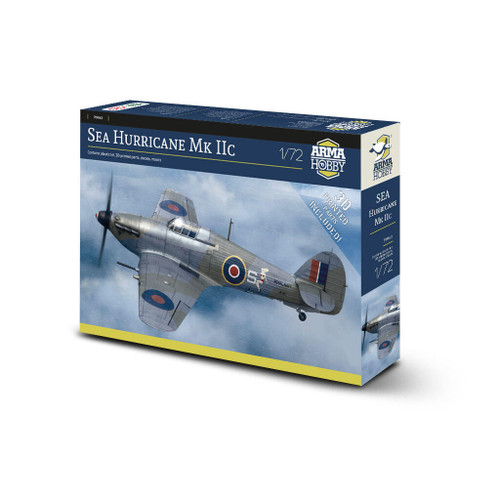Description
Hurricane Mk IIc quarter scale kit. New Tool 2023
- Plastic parts (3 grey sprues and 1 clear sprue)
- Decals (3 marking variants)
- Canopy and wheel masks
Markings options:
- Hurricane Mk. IIC “Night Intruder”, BE581/JX-E, 1 Squadron RAF, Tangmere, May 1942, pilot F/L Karel Kuttelwascher
- Hurricane Mk.IIC Z3152/FM-A. 257 Squadron RAF. Pilot S/Ldr Robert Stanford Tuck DSO, DFC & Two Bars, AFC. RAF Coltishall airfield, May 1941
- Hurricane Mk.IIC LF644/WC-D. 309 Squadron PAF. RAF Drem airfield, May-July 1944
The Hurricane Mk IIc
The Hawker Hurricane Mk II was developed after the first combat experience gained in the battles over France, which quickly showed the main weaknesses of the first version of the fighter. Sydney Camm's design team set itself to improve the plane’s performance and armament effectiveness. On June 11, 1940, the prototype of the Mk II version was flown, equipped with a Rolls-Royce Merlin XX engine with a two-stage compressor. With this engine, the Hurricane reached 342 mph (550 km/h). The first production Hurricane Mk IIA went into action in September 1940.
The second stage of modernisation was to improve firepower by increasing the number of machine guns to twelve, resulting in the appearance of the Mk IIB version. At the same time, work was carried out on adapting the wing to the installation of 20mm Hispano-Suiza HS.404 cannons. Cannon-armed version, marked Mk IIC, appeared in units (242, 3 and 257 Squadrons RAF) in March 1941 and was produced without major changes until July 1944. A total of 4,711 Mk IIC machines were produced, serving on almost all fronts during the Second World War.
The aircraft, designed as an interceptor, was adapted over time to the role of an intruder, a night fighter (a version equipped with radar was also created), a carrier-based fighter, an attack aircraft and a light bomber. He lasted the longest in the first-line units in the latter role. The Mk IIC version also became the starting point for the Mk IID anti-tank version, equipped with two 40mm Vickers S cannons and the Mk IV - a specialised assault version that could carry bombs or rockets.
A tropicalised version was used outside the European theatre of operations, equipped with a distinctive dust filter. The pilots of the Polish Air Force met the Hurricane Mk IIC as early as in the autumn of 1941 during exchange postings in the No. 87 Squadron. In 1943, single examples were sent to the No. 318 Fighter-Reconnaissance Squadron, and in April 1944, the entire Polish No. 309 Squadron was equipped with this type and operated from airfields in Scotland on patrol duty.

























